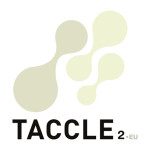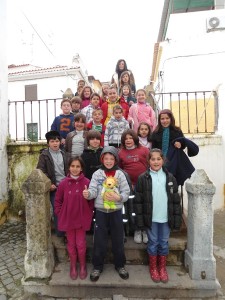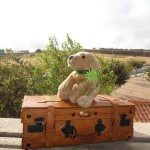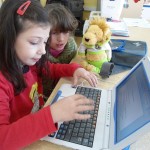This activity is planned to engage students between 6-8 years old from two distant groups of schools (or the same country or from different countries and regions).
Basically, it consists in sending for the partner school (by mail) a doll traveler, representative of each class, simulating the journey of a student from one class to another location. The travel can be short (1 month), medium (1 semester) or long term (1 academic year). During the journey, the traveler seeks to know the region to visit, reporting their experiences in travel diary and sharing them with their classmates by sending email messages, or publishing news, photos and videos in a blog. This activity has as main objectives to promote an intensive practice and contextualized reading and writing, as well as provide contact with students from different educational, social and cultural realities and your own natural and cultural heritage on the pretext of making known to the traveler.
The development of this activity requires that previously found a partner school is interested in participating and that between teachers and students of the two schools is planned work (objectives, tasks, scheduling, etc.).. As the activity implies the involvement of the educational community is desirable requested the cooperation of other teachers, family members and local organizations.
The main development phases of the work are as follows:
a) Choose the traveler (dolls brought from home by the children).
b) Organization of the travel bag (documentation on the land of origin, travel diary, identity, clothes, etc.).
c) Exploration Google Maps for simulated travel, the location of the your city and the city of your partners, etc.
d) Expedition Traveler via postal mail.
e) Engagement of the traveler in all curricular activities and outside thecurricular class (definition of a roadmap of the locality or region with the most important points to go by the traveler during the study visits).
f) Organization of a scale to the Traveler overnights, which must accompany students home after school and return them the next day.
g) Composition of daily travel.
h) Collection of information on the historical, natural and cultural locality or region (queries on the Internet, the library, in tourism guide, in local newspapers, interviews the family and population, participation in specific events, …)
i) Submission of regular reports to the partner school on the experiences of the traveler, especially email messages with or without attachments (text, photos, videos, …).
j) Monitoring travel (receive, read and analyze the information received, ask questions, …)
k) Organization of a picture, or blog dossier containing the information shared.
l) Preparation of the return journey (goodbye party; suitcase with souvenirs of the region visited).
m) Exploration travel diary built by the traveler with the help of colleagues.
Internet access in the classroom, some money exchanges via postal mail, an email account and subscription to a blog.
Ex: http://projectoviajantes.blogspot.com/
In case of technological failure the project can be developed using the cell phone through SMS.
Hints and tips
A simulation of an activity journey would be too abstract for children of this age and why we chose to send a doll traveler by post. The dolls travelers represent real people with whom children can relate directly and physically. Thus, we tried to find compensation in terms of human values and affectivity, friendship, solidarity.
Valorizing the extended and contextualized writing we are developing reading and writing skills. Pupils write more with great enthusiasm and with much creativity. In this kind of activity students are using writing to report events, to interact, to communicate with colleagues and friends from another school, giving another value another sense and meaning to their productions.
Safety
Depending on the security policy of Internet access each school or permission of parents may be necessary to avoid publication of photographs of students or hide the face of the students in close-up photos. It is important to give special attention to moderating blog comments.
Other opportunities to use the same software
Occasionally, some of the activities can be developed taking advantage of the online synchronous communication with the software provided by Skype or specific software available in the smartphone of some teachers and students.
Having regard that this is an activity that coexist in “new” and “old” technology, students can be encouraged to exchange postcards and other objects by mail.
 Eventually, can also be provided participation in radio or television stations.
Eventually, can also be provided participation in radio or television stations.
The family involvement is very important, both for the traveler to visit the home of each student, such as the transmission of local and regional traditions in possible displacements to school. Should also be encouraged to interact with the community by writing comments on blog posts. Whenever possible should be organized a face-to-face meeting between participants who will follow the doll traveler back home.
By: José Luís Carvalho / Maria da Luz Figueiredo
Elvas / Figueira da Foz, Portugal
This post is also available in: Portuguese (Portugal)







 English
English Nederlands
Nederlands Deutsch
Deutsch Italiano
Italiano Español
Español Português
Português Română
Română Cymraeg
Cymraeg
I love the idea of sending a doll – for 6 to 8 year olds describing an imaginary trip is quite hard but this makes it much more concrete. It’s like a digital Paddington Bear!
(By the way, for those of you who might be wondering, I haven’t suddenly learned to speak Portugese – it took 30 secs to run this through Google translate and even if the translation isn’t perfect, it’s more than good enough to understand the idea. So – please, everyone, feel free to comment in your own language even if a post is written in another language!)
Hi Jenny! Thank you for this comment :o)
I published a new version of this activity in English.
Regards
LOL – thanks Carla – you are making it all too easy for us!! Seriously, we really appreciate your translating it.
But I would still urge people who want to post something but feel daunted by feeling they have to translate it into English to just post it in their own language. The rest of us can always use google translate and reply in whatever language we choose.
Thank you for your example.
It might be worth while to focus more on the ICT component. For example describe HOW to set up the blog (www.projectoviajantes.blogspot.co.uk is the example used in the activity) .
You could perhaps give some guidance on how they set up this blog, how, practically, it is maintained and by whom? You could also integrate the Skype aspect (mentioned briefly in ‘other ideas’) into the main body of the activity which would improve the e-learning aspect.